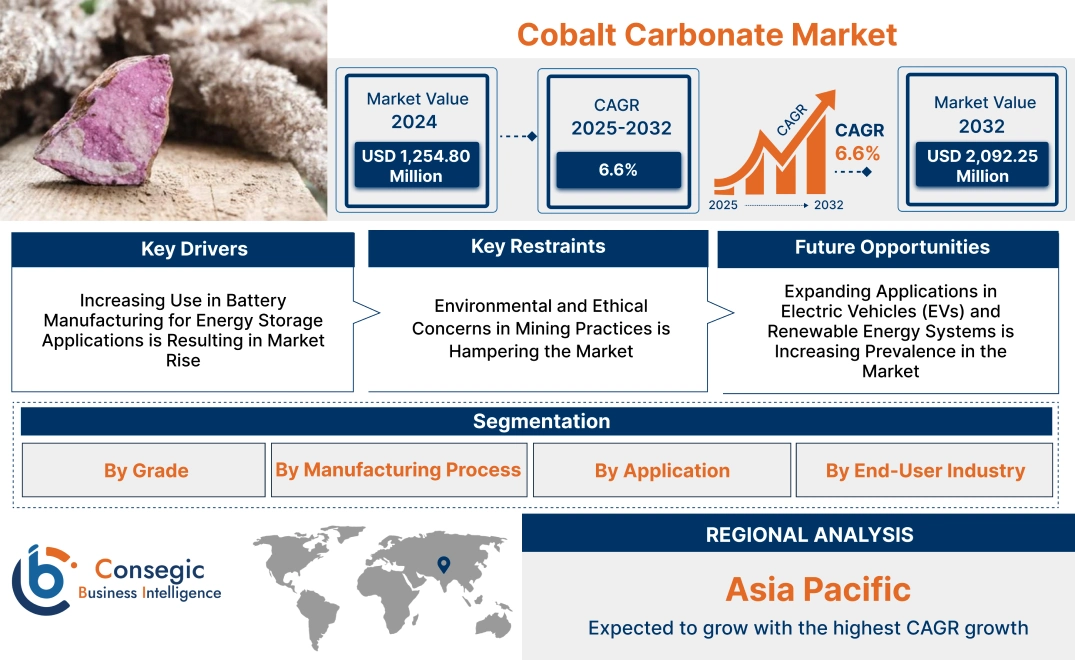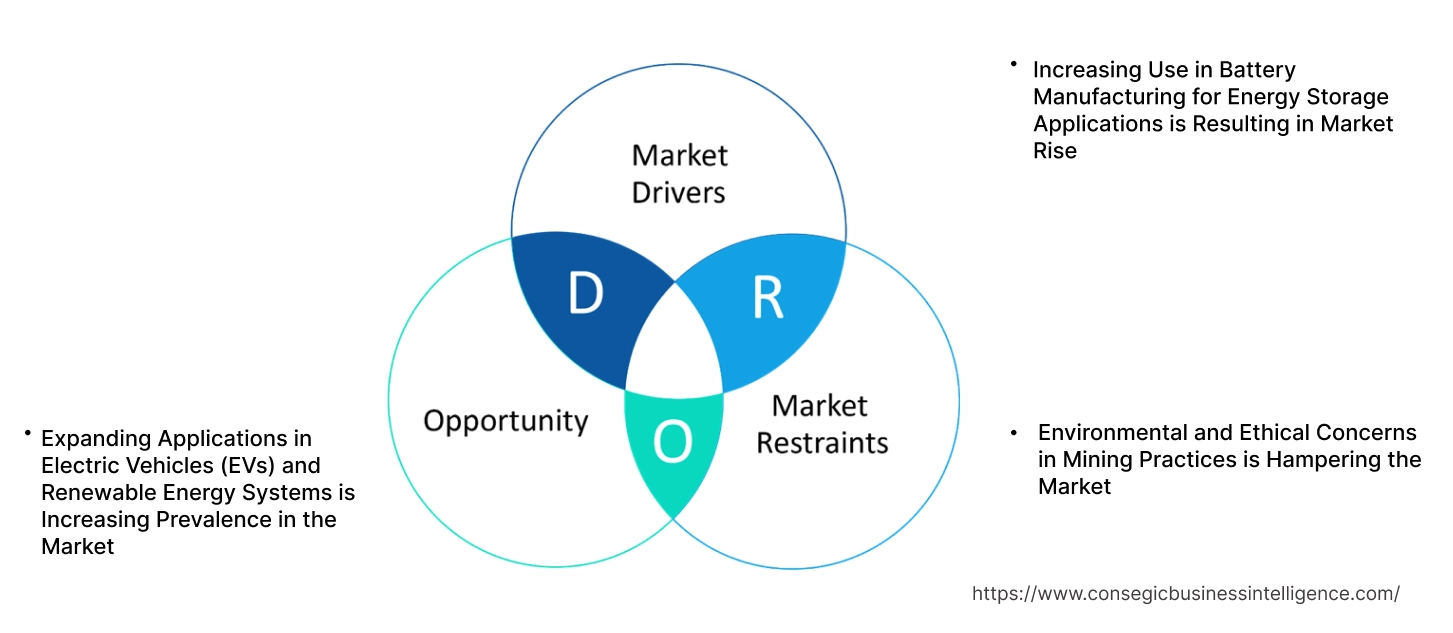- Summary
- Table Of Content
- Methodology
Cobalt Carbonate Market Size:
Cobalt Carbonate Market size is estimated to reach over USD 2,092.25 Million by 2032 from a value of USD 1,254.80 Million in 2024 and is projected to grow by USD 1,315.26 Million in 2025, growing at a CAGR of 6.6% from 2025 to 2032.
Cobalt Carbonate Market Scope & Overview:
Cobalt carbonate is a versatile chemical compound widely used in various industries for its catalytic, pigmenting, and nutritional properties. This compound is a key raw material in the manufacturing of cobalt-based pigments, catalysts, and battery materials. Key characteristics of cobalt carbonate include its high purity, chemical stability, and compatibility with multiple industrial processes. The benefits include enhanced performance in catalysis, improved color vibrancy in pigments, and essential nutrient supplementation in animal feed. Applications span ceramics, paints and coatings, battery production, and agricultural feed additives. End-users include ceramic manufacturers, battery producers, and agricultural industries, driven by the increasing cobalt carbonate market trends for advanced materials in energy storage, rising adoption of cobalt-based catalysts, and the growing focus on nutrient-rich animal feed formulations.
Key Drivers:
Increasing Use in Battery Manufacturing for Energy Storage Applications is Resulting in Market Rise
Cobalt carbonate is a key material in the production of cathodes for lithium-ion batteries, which are central to energy storage systems in electric vehicles (EVs), portable electronics, and renewable energy applications. Its role in enhancing the energy density and stability of batteries has positioned it as an essential component in the transition toward electrification and sustainable energy solutions. Cobalt carbonate contributes to improved performance and longevity, which are critical factors for modern battery technologies.
Trends in renewable energy adoption and advancements in battery chemistry are driving the integration of cobalt carbonate into energy storage systems. Its use supports the development of high-capacity batteries that align with the growing emphasis on reliable and efficient energy storage. The analysis highlights that as industries focus on decarbonization and energy efficiency, cobalt carbonate will remain pivotal in achieving these objectives.
Key Restraints:
Environmental and Ethical Concerns in Mining Practices is Hampering the Market
The extraction of cobalt, the primary source material, is often associated with significant environmental and ethical issues. Mining activities, particularly in regions with limited regulatory oversight, can lead to habitat destruction, water pollution, and unsafe working conditions. These concerns have drawn increased scrutiny from governments, non-governmental organizations, and end-users, impacting the reputation and supply chain stability of cobalt-based products.
Trends in responsible sourcing and environmental compliance are reshaping the market dynamics, with stakeholders demanding transparency and ethical practices. Manufacturers and suppliers are being compelled to adopt sustainable mining and processing methods to address these challenges. Analysis indicates that resolving these issues is critical for maintaining the long-term viability of cobalt carbonate in various applications.
Future Opportunities :
Expanding Applications in Electric Vehicles (EVs) and Renewable Energy Systems is Increasing Prevalence in the Market
The shift toward electric mobility and renewable energy infrastructure creates new opportunities for cobalt carbonate in advanced battery systems. As EVs gain prominence in reducing global carbon emissions, lithium-ion batteries incorporating cobalt carbonate are essential for achieving higher energy efficiency and range. Similarly, renewable energy systems, such as solar and wind power, rely on robust energy storage solutions to ensure consistent performance.
Trends in clean energy and sustainable transportation are driving innovations in battery technologies, where cobalt carbonate plays a vital role. Analysis suggests that its expanding applications in EVs and renewable energy systems not only support decarbonization goals but also align with the broader global focus on building resilient and sustainable energy networks. By leveraging these opportunities, manufacturers can contribute to advancing the clean energy transition while capitalizing on emerging market expansion.
Cobalt Carbonate Market Segmental Analysis :
By Grade:
Based on grade, the market is segmented into industrial grade, battery grade, and pharmaceutical grade.
The battery grade segment accounted for the largest revenue cobalt carbonate market share in 2024.
- Battery-grade cobalt carbonate is a vital precursor in the manufacturing of lithium-ion batteries, particularly in the production of cathode materials for electric vehicles (EVs) and energy storage systems.
- The increasing adoption of EVs, supported by stringent regulations and government incentives for sustainable transportation, has significantly bolstered the development of battery-grade cobalt carbonate.
- Its high purity and consistent quality ensure optimal battery performance, making it indispensable for the rapidly expanding battery manufacturing sector.
The pharmaceutical grade segment is anticipated to register the fastest CAGR during the forecast period.
- Pharmaceutical-grade cobalt carbonate is extensively used in the production of dietary supplements, vitamins, and medicinal compounds due to its role in supporting biological processes, such as red blood cell production and vitamin B12 synthesis.
- The rising surge for enriched animal feed additives to improve livestock health and productivity has further driven the adoption of pharmaceutical-grade cobalt carbonate.
- Additionally, advancements in pharmaceutical manufacturing and growing awareness of dietary health supplements are expected to contribute to the rapid cobalt carbonate market growth of this segment.
By Manufacturing Process:
Based on the manufacturing process, the market is segmented into hydrometallurgical process, pyrometallurgical process, and biotechnological process.
The hydrometallurgical process segment accounted for the largest revenue share in 2024.
- The hydrometallurgical process is widely adopted for cobalt carbonate production due to its high efficiency and ability to produce high-purity products from a variety of ore grades.
- This method, involving leaching and precipitation techniques, is crucial for meeting the quality requirements of applications in batteries, pigments, and ceramics.
- The increasing surge for sustainable and efficient extraction methods, coupled with the rising focus on environmentally friendly production, has reinforced the dominance of the hydrometallurgical process in the market.
The biotechnological process segment is anticipated to register the fastest CAGR during the forecast period.
- The biotechnological process leverages microorganisms to extract cobalt from ores and industrial waste, offering a sustainable alternative to conventional methods.
- This innovative approach minimizes energy consumption and greenhouse gas emissions, aligning with the global shift toward greener technologies.
- As industries prioritize circular economy practices, biotechnological processes are gaining traction for producing high-quality cobalt carbonate.
- The growing investment in research and development for bio-based extraction methods is expected to propel this segment’s growth.
By Application:
Based on application, the market is segmented into battery precursors, pigments & dyes, catalysts, feed additives, ceramic glazes, and others.
The battery precursors segment accounted for the largest revenue in 28.40% of the cobalt carbonate market share in 2024.
- Cobalt carbonate is a key component in producing battery precursors, particularly for lithium-ion batteries used in electric vehicles and energy storage systems.
- Its role in enhancing battery efficiency, energy density, and lifespan has made it essential for the rapidly growing battery industry.
- The surge in EV production and the expansion of renewable energy projects globally have significantly increased the cobalt carbonate market demand in this segment.
The feed additives segment is anticipated to register the fastest CAGR during the forecast period.
- Cobalt carbonate is extensively used as a feed additive in the agriculture sector to support livestock health by improving vitamin B12 synthesis and metabolism.
- The rising focus on enhancing animal nutrition and productivity, coupled with the increasing demand for high-quality animal protein, has driven cobalt carbonate market growth in this segment.
- Trends in animal husbandry practices and the expansion of the global agriculture industry are expected to further boost demand for cobalt carbonate in feed additive applications.
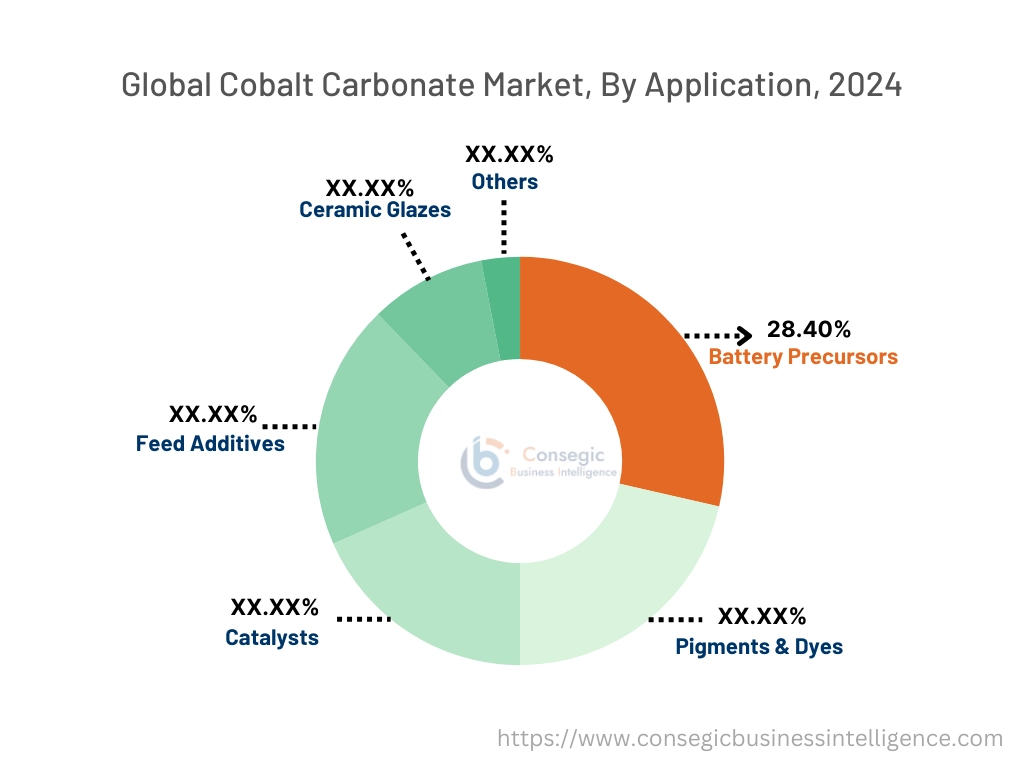
By End-Use Industry:
Based on the end-use industry, the market is segmented into automotive, electronics, chemicals, pharmaceuticals, ceramics, agriculture, and others.
The automotive segment accounted for the largest revenue share in 2024.
- The automotive industry is the largest consumer of cobalt carbonate, driven by its critical role in producing lithium-ion batteries for electric vehicles.
- With the global push for electrification and sustainability, major automakers are ramping up EV production, significantly increasing the demand for battery-grade cobalt carbonate.
- Additionally, advancements in battery technologies, such as high-capacity cathode materials, have further reinforced the importance of cobalt carbonate in the automotive sector.
The electronics segment is anticipated to register the fastest CAGR during the forecast period.
- Cobalt carbonate is widely used in the electronics industry for producing batteries in portable devices such as smartphones, laptops, and wearable gadgets.
- The increasing cobalt carbonate market trends for high-performance consumer electronics, along with the rising adoption of connected devices in smart homes and IoT ecosystems, have fueled the development of this segment.
- Moreover, the integration of cobalt-based batteries in advanced electronic products and the focus on extending battery life are expected to drive significant growth in the electronics sector.
Regional Analysis:
The regions covered are North America, Europe, Asia Pacific, the Middle East and Africa, and Latin America.
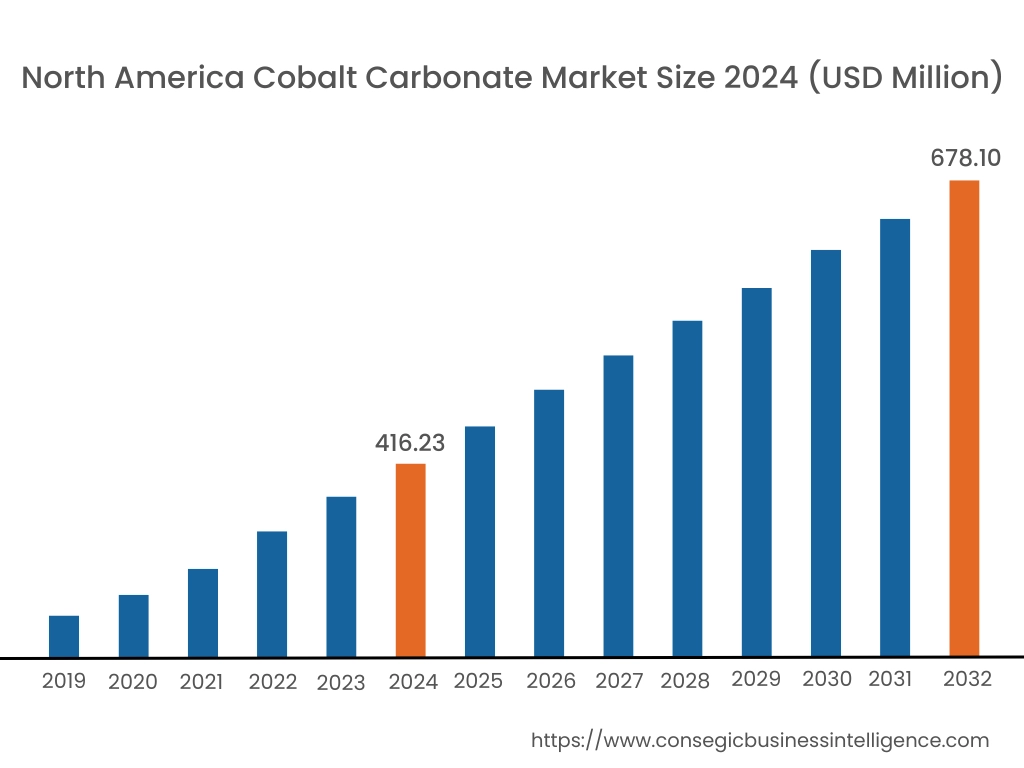
In 2024, North was valued at USD 416.23 Million and is expected to reach USD 678.10 Million in 2032. In North America, the U.S. accounted for the highest share of 72.80% during the base year of 2024. North America holds a significant share of the market, driven by the growing trends for cobalt-based materials in battery production, catalysts, and pigments. The U.S. leads the region due to its robust energy storage and automotive industries, focusing on cobalt carbonate as a precursor for lithium-ion batteries in electric vehicles (EVs). Additionally, the chemical sector uses cobalt carbonate in catalysts for industrial applications. As per the cobalt carbonate market analysis, Canada contributes through its mining sector, which supplies cobalt for downstream applications. However, reliance on imported cobalt and fluctuating prices may pose challenges in the region.
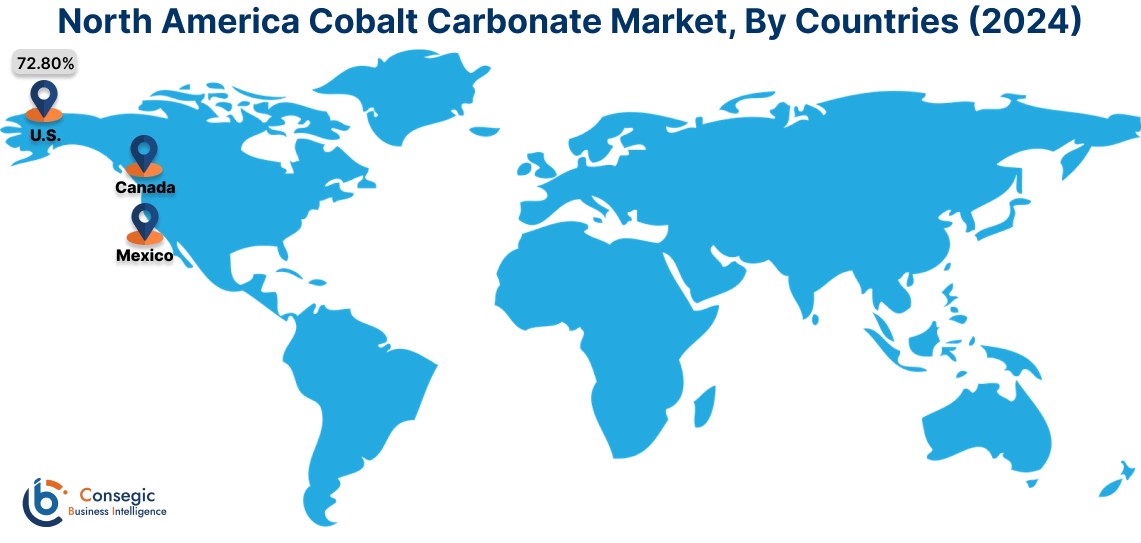
In Asia Pacific, the market is experiencing the fastest growth with a CAGR of 7.0% over the forecast period. The cobalt carbonate market analysis, results in rapid fueling of industrialization, increasing EV production, and growing trends for rechargeable batteries in China, Japan, and South Korea. China dominates the market with extensive use of cobalt carbonate in lithium-ion battery production and as a pigment in ceramics and glass. India’s expanding chemical and ceramics industries also support cobalt carbonate market expansion. Japan and South Korea leverage cobalt carbonate for advanced battery technologies and electronic components. However, dependence on imported raw materials and fluctuating global cobalt prices may create challenges for market stability.
Europe is a prominent market for cobalt carbonate, supported by the region's focus on sustainable energy solutions and the rapid extension of the EV market. Countries like Germany, France, and the UK are key contributors. As per the analysis, Germany drives development for cobalt carbonate in battery manufacturing for EVs and energy storage systems. France emphasizes its use in pigments for ceramics and industrial coatings, while the UK focuses on utilizing cobalt carbonate in catalysts for chemical production. However, stringent EU regulations on cobalt usage and environmental sustainability may impact market rise and encourage recycling efforts.
The Middle East & Africa region is witnessing steady growth in the cobalt carbonate market, driven by increasing investments in renewable energy and industrial catalysts. Countries like South Africa, a major cobalt producer, leverage its mining capabilities to supply cobalt carbonate for regional and global cobalt carbonate markets. In the Middle East, nations like Saudi Arabia and the UAE are adopting cobalt-based materials in energy storage systems and catalysts for petrochemical industries. However, limited downstream processing facilities and reliance on exports of raw materials may restrict the market’s value addition in the region.
Latin America is an emerging market for cobalt carbonate, with Brazil and Cuba leading the region. Brazil’s expanding chemical and ceramics industries drive cobalt carbonate market demand for cobalt carbonate in pigments and catalysts. Cuba, a significant cobalt producer, contributes through its mining sector, exporting cobalt carbonate for global applications. The region is also exploring cobalt carbonate market opportunities in battery production to support the growing EV market. However, economic instability and limited manufacturing infrastructure may pose challenges to market development in some parts of the region.
Top Key Players and Market Share Insights:
The cobalt carbonate market is highly competitive with major players providing products to the national and international markets. Key players are adopting several strategies in research and development (R&D), product innovation, and end-user launches to hold a strong position in the cobalt carbonate market. Key players in the cobalt carbonate industry include -
- Zhejiang Huayou Cobalt Co., Ltd. (China)
- American Elements (USA)
- SkySpring Nanomaterials, Inc. (USA)
- Spectrum Laboratory Products, Inc. (USA)
- Strem Chemicals, Inc. (USA)
- Umicore S.A. (Belgium)
- GFS Chemicals, Inc. (USA)
- Nanochemazone (Canada)
- Noah Technologies Corporation (USA)
- Shanghai Xinglu Chemical Technology Co., Ltd. (China)
Recent Industry Developments :
Supply Chain Production:
- In August 2024, Glencore, a leading global commodity trading and mining company, announced that it had ceased stockpiling cobalt, a critical material for electric vehicle (EV) batteries. CEO Gary Nagle stated that the company had begun selling down its cobalt inventories, indicating a shift in market strategy. With significant production concentrated in the DRC and increased output from companies like CMOC Group, supply chain dependencies may shift, influencing sourcing strategies for cobalt derivatives.
Cobalt Carbonate Market Report Insights :
| Report Attributes | Report Details |
| Study Timeline | 2019-2032 |
| Market Size in 2032 | USD 2,092.25 Million |
| CAGR (2025-2032) | 6.6% |
| By Grade |
|
| By Manufacturing Process |
|
| By Application |
|
| By End-Use Industry |
|
| By Region |
|
| Key Players |
|
| North America | U.S. Canada Mexico |
| Europe | U.K. Germany France Spain Italy Russia Benelux Rest of Europe |
| APAC | China South Korea Japan India Australia ASEAN Rest of Asia-Pacific |
| Middle East and Africa | GCC Turkey South Africa Rest of MEA |
| LATAM | Brazil Argentina Chile Rest of LATAM |
| Report Coverage |
|
Key Questions Answered in the Report
What is the expected size of the Cobalt Carbonate Market by 2032? +
Cobalt Carbonate Market size is estimated to reach over USD 2,092.25 Million by 2032 from a value of USD 1,254.80 Million in 2024 and is projected to grow by USD 1,315.26 Million in 2025, growing at a CAGR of 6.6% from 2025 to 2032.
What factors are driving the growth of the cobalt carbonate market? +
The market is primarily driven by its increasing use in battery manufacturing for electric vehicles and renewable energy storage systems.
What are the challenges facing the cobalt carbonate market? +
Environmental and ethical concerns associated with cobalt mining, such as habitat destruction, unsafe working conditions, and regulatory scrutiny, are significant challenges.
Which segment dominates the cobalt carbonate market by grade? +
The battery-grade segment holds the largest market share due to its critical application in lithium-ion battery production for electric vehicles and energy storage systems.
